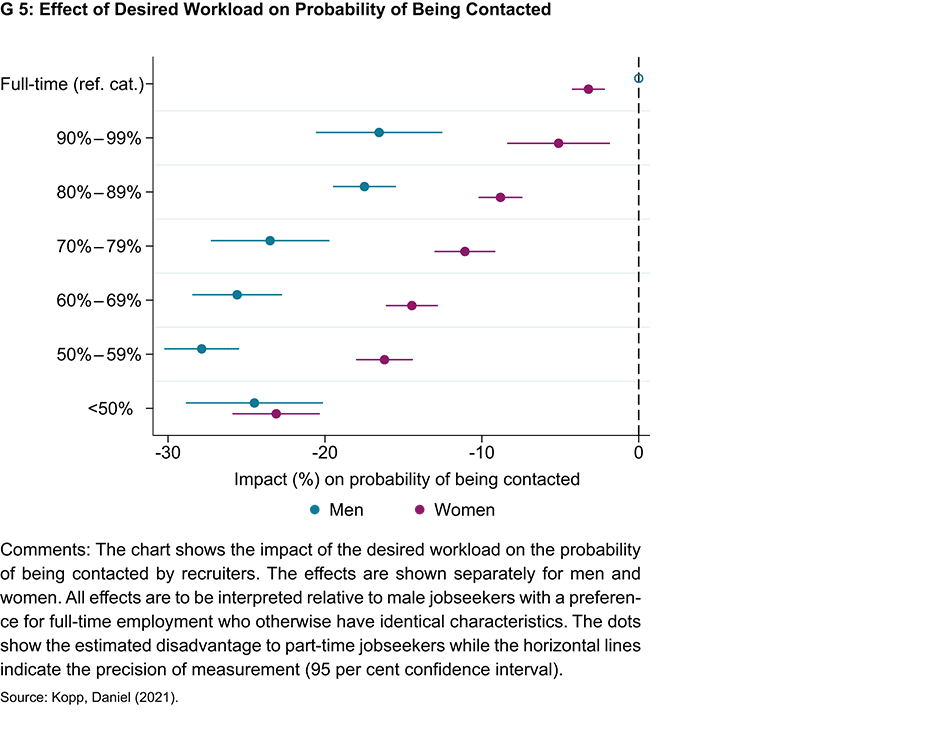Men seeking part-time jobs are disadvantaged
- Labour Market
- KOF Bulletin
Gainful and inactive work is still unequally distributed between the sexes. One reason is that few men work part-time. This is partly due to the fact that men looking for part-time jobs are discriminated against by recruiters.

While women do around 60 per cent of the unpaid work in Switzerland, the situation is exactly the opposite for paid work, where men are responsible for 60 per cent of the total volume of work (source: Swiss Federal Statistical Office, FSO). This is because women are less likely to pursue gainful employment and because they work part-time much more often than men. While 59 per cent of employed women have a part-time job, the corresponding figure for men is 18 per cent (source: FSO). This partly has to do with jobseekers. Men are significantly less likely to seek part-time employment than women. Among other things, this is probably due to persistent traditional gender roles, according to which women do the housework while men earn the money. However, companies also contribute to the unequal distribution of gainful employment. This is shown by an as yet unpublished study that analyses the search and selection behaviour of thousands of HR managers on one of the largest online labour market platforms in Switzerland.
Registered jobseekers can post their (anonymised) profiles on Job-Room, the online labour market platform run by Switzerland’s State Secretariat for Economic Affairs. Recruiters can then click through the profiles to search for suitable personnel for their vacancies. Every single one of these clicks was recorded over a ten-month period in 2017. During this time, more than 43,000 recruiters performed around 450,000 searches and clicked through the profiles of more than 200,000 jobseekers. In total, more than four million profile views – i.e. four million decisions to accept or reject a jobseeker – were documented. This huge amount of data enables us to examine which jobseekers’ characteristics increase the likelihood that they will be contacted by recruiters and which characteristics are a barrier. One of these characteristics is the desire to work part-time. Jobseekers on Job-Room can indicate what percentage of full-time employment they wish to work. What impact does the desire for part-time work have on the chance of being contacted by recruiters?
That depends on whether the person concerned is male or female. Chart G 5 shows the effect of desired workload on the likelihood of men and women being contacted. This compares people who are assessed by the same recruiter for the same job and have the same characteristics apart from the desired workload and gender. The reference category is men seeking a full-time position. The chart shows that the desire for part-time work is a barrier to employment for both men and women, with the likelihood of contact decreasing the lower the desired workload. However, the disadvantage of wanting a part-time job is much more pronounced for men than for women. A man seeking a 90 per cent job is 16 per cent less likely to be contacted than a man with otherwise identical characteristics seeking a full-time job. For women, the disadvantage is less than half as great. The disadvantage is greatest for men looking for between 50 per cent and 59 per cent employment. Their likelihood of being contacted is reduced by as much as 28 per cent. This effect on the likelihood of being contacted is significantly greater than the effect of other characteristics such as education or work experience.

A part-time working man does not fit the traditional role model
Why are men looking for part-time jobs more heavily penalised by recruiters than women? Since this analysis of the effects compared jobseekers who were being considered by the same recruiter for the same job, it cannot be due to differences between the occupations in which men and women are looking for work. Rather, it seems that recruiters are partly guided by traditional gender role models in their hiring decisions.
In contrast to a woman working part-time, a man working part-time does not fit the traditional role model according to which the man is the main breadwinner and the woman looks after the home. Recruiters appear to be suspicious of men who want part-time employment – even if the man is looking for a 90 per cent job. While the disadvantage for women seeking part-time work increases continuously the smaller the part-time job sought, we observe that men seeking full-time employment are much more likely to be contacted than those seeking a 90 per cent part-time job. This suggests that the disadvantage to men is mainly due to the signal that a desire for part-time employment sends out and has less to do with any real difficulties in integrating part-time employees into the working environment. This may well be an unconscious reaction on the part of recruiters.
More equal distribution of gainful employment is being hindered
What are the consequences of the greater discrimination against men seeking part-time work compared with women who do so? Among other things, it means that men have even less incentive to reduce their workload. This hinders the process of achieving a more equal distribution of gainful and inactive work between the sexes. If we want to encourage greater balance in the amounts of paid and unpaid work done by men and women, a rethink will therefore have to take place not only on the part of workers and jobseekers but also among companies.
Reference
Kopp, Daniel (2021): The gender biased part-time penalty in hiring. Evidence from recruiter behavior on an online recruitment platform. Unpublished manuscript. KOF Analysen Sommer 2021.
Contact
KOF Konjunkturforschungsstelle
Leonhardstrasse 21
8092
Zürich
Switzerland